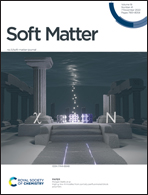Protonation induced redshift in the fluorescence of a pyridine derivative as a potential anti-counterfeiting agent†
Abstract
A simple pyridine-based compound, i.e. (2,4,6-tris(4-(hexyloxy)phenyl)pyridine), was synthesized and exhibited excellent solubility in various organic solvents owing to the presence of three 4-n-hexyloxy chains in its molecular structure. Further, we studied the effect of various solvents on its absorption and emission properties. We observed a greater extent of redshift in the chloroform solvent compared to the rest of the solvents. In fact, the observed redshift was attributed to protonation of the pyridine moiety by HCl (present due to the oxidative photo-decomposition of chloroform) in the solvent. Therefore, we also studied the acidochromic properties of the compound using acetic acid (AA), trifluoroacetic acid (TFA), and hydrochloric acid (HCl). We found that the compound sensed the HCl vapor much more efficiently than the TFA and AA vapours. Additionally, DFT analysis suggested a narrow theoretical bandgap for the protonated molecule when compared to the neutral molecule, explaining the redshift in the absorption and emission spectra of the protonated molecule. Furthermore, the compound exhibited a good level of aggregation induced enhanced emission (AIEE) in the THF–water system. In fact, compounds showing both AIEE and acidochromism are rarely reported in the literature. Finally, we employed it as an anti-counterfeiting agent based on its acid–base vapour sensing capability.



 Please wait while we load your content...
Please wait while we load your content...